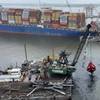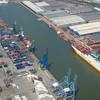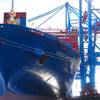Q&A: Growing Blue Economy Opportunities for U.S. Exporters
U.S. Commercial Service previews September 20-22 export forum
The growing demand for marine technologies is generating new export possibilities for U.S. companies. To help American businesses pursue these opportunities, the Department of Commerce is hosting Discover Global Markets: The Blue Economy, in Providence, R.I., Sept. 20-22, 2022. International Trade Specialist Maryanne Burke leads the Marine Technology Team of the International Trade Administration (ITA). Maryanne is part of ITA’s U.S. Commercial Service’s global network of offices located in 100+ cities across the United States and in U.S. embassies and consulates in more than 75 markets. In the below Q&A, she shares some insights on how U.S. companies can take advantage of the Blue Economy event and agency export resources to expand their export horizons.
- Could you give readers a snapshot of the Blue Economy event, how can U.S. companies benefit from attending?
We’re seeing a new age in ocean technology, sustainability and logistics, and Discover Global Markets: The Blue Economy will highlight growing overseas market opportunities for U.S. businesses in the marine technology sector. Like no other event, the Sept. 20-22 forum brings together U.S. businesses, foreign buyer delegations, and U.S. Commercial Service marine industry experts from 20 countries. Through export counseling and business-to-business (B2B) matchmaking, U.S. businesses can benefit from market intelligence, trade leads, partnering opportunities, and potential export sales. It’s an excellent venue for exporters to both grow their bottom line with export sales and improve their competitiveness by diversifying into new markets. Discover Global Markets events, held annually, focus on different industries and regional markets. During its ten-year history, the series has attracted thousands of U.S. business participants resulting in millions of dollars in export sales.
- Which markets will be represented at the show?
We’ll have a strong geographic presence, representing a truly global showcase. U.S. companies will gain market insights from U.S. Commercial Service industry experts from U.S. embassies around the world, including: Australia, Brazil, Canada, France, India, Indonesia, Italy, Japan, Korea, Mexico, Singapore, Spain, the Netherlands, Norway, Thailand and the United Kingdom, as well as many others. These markets represent some of the best growth prospects in the marine technology sector, offering both short and long-term industry opportunities for U.S. companies.
- What are some opportunities in these countries?
Overall, marine technologies are in demand for both large-scale foreign government projects and independent, non-government organization projects. Opportunities are wide-ranging, covering port development and technologies, underwater surveillance, subsea imaging for ocean floor mapping, offshore wind ecosystems, weather instrumentation, ocean science and exploration. Another focus is clean “smart” technology for use in marine transportation.
In many cases, growth and demand abroad is higher than in the U.S. domestic market. For example, some parts of Europe have a strong interest in port development, while in the Indo-Pacific, countries are looking for the latest technologies to monitor coastal flooding. More and more, we’re seeing growing opportunities driven by evolving global trends in technology, demographics, and sustainable development.
Examples of market opportunities include:
- The United Kingdom’s maritime economy is the largest in Europe, the fifth-largest in the world for U.S. goods exports and the largest market in the world for U.S. service exports. Technologies are in demand for smart ports, decarbonization solutions, and green innovations for shipping and offshore wind energy. Technology is also sought for intelligent and autonomous ships, and autonomous underwater vehicles that are sensor agnostic. For example, the Royal Navy is seeking to develop a range of fully autonomous systems for surveillance, reconnaissance and underwater data gathering, among other uses.
- Italy will invest $3.1 billion (2.8 billion euros) by 2026 to modernize its ports. These investments are part of the National Recovery and Resilience Plan, Italy’s strategy to kickstart its economy since the Covid-19 pandemic. Much of this spending is earmarked to increase port capacity and will require new port technologies and services. Other funding will make ports more ecologically sustainable, or more efficient and secure through digitalization. This is in addition to $2.5 billion (2.3 billion euros) in investment already planned for the Ports of Genoa. U.S. companies with innovative solutions in these sectors may benefit from increased spending.
- India’s maritime sector envisions an overall investment of $45 billion across ports, shipping, and inland waterways categories by 2030. The focus will be on improving infrastructure, efficiency, services, capacity building and logistics. It will also expand ship building and promote a safe and sustainable “green” maritime sector. By 2030, India plans to reach 140 million tons per year transiting its national waterway network. To reach this goal, the Inland Waterway Authority of India plans to develop and modernize 5,000 km of Inland Waterways. India needs state-of-the-art port and marine technologies such as equipment and services for security, logistics, vessel tracking, oil spill detection and contingency preparedness, dredging, and underwater exploration and mapping.
- Could you give some insight on the business-to-business matchmaking and industry expertise at the show?
The U.S. Commercial Service is the trade and investment promotion arm of the U.S. Department of Commerce’s International Trade Administration. Through our in-country presence at U.S. embassies abroad, our trade experts have in-depth market knowledge and connections to buyers of U.S. products and services, as well as market expertise in the marine technology sector. And so, we bring these skillsets to the show, along with several foreign buyer delegations.
Our value is knowing the key players and opportunities to bring U.S. businesses and prospective foreign buyers together. We do this by arranging business-to-business (B2B) matchmaking meetings based on their mutual needs and interests. Because the U.S. Commercial Service screens buyers in advance, we know they are interested in U.S. marine technologies and ready to do business. This arrangement is a real advantage for U.S. exporters, particularly for small and medium-sized businesses, compared to searching for suitable foreign business partners interested in marine technologies on their own.
Through networking opportunities, U.S. businesses will hear from original equipment manufacturers (OEMs) and prime contractors about overseas projects and their supplier needs, participate in general networking activities, and learn about U.S government export programs.
Businesses attending previous Discover Global Markets events have noted several benefits of the two-day event. Among these are the time and resources saved from having to travel to meet contacts, new leads generated, insights gained for honing export strategies, and obtaining real-time market information from experts to understand in-depth, what is going on internationally beyond what is seen in the media.
- How does the business-to-business matchmaking work?
On the Blue Economy registration form, a U.S. company enters their information into a database platform about their product or service and the markets they are looking to sell to. About a month ahead of the event, participants can search the database to identify potential partners and arrange matchmaking meetings. U.S. businesses can also arrange meetings at the event. U.S. Commercial Service industry experts will also be facilitating B2B meetings on the conference floor.
- What are some recommendations on how to best pursue international opportunities?
Contacting the U.S. Commercial Service is a great place to start. Our trade specialists can help develop a customized export strategy that identifies priority markets with the strongest potential for export success. For more information on our services and events, visit the Marine Technology Team website trade.gov/marine-technology-industry, or your contact your local U.S. Commercial Service office at trade.gov/commercial-services-offices-us.
Tips for Marine Technology Exporters
- Take advantage of trade shows to make connections, and let people know you will be there in advance.
- Conduct your due diligence by knowing your customer and their end-use, understanding local regulations, relying on local distributors for information, and being aware of U.S. Government export controls and licensing requirements.
- Check out the U.S. Commercial Service’s Country Commercial Guides which offer the latest on individual country market conditions, business environment, leading industry sectors, and doing business in each market.
- Consult with legal counsel on ways to protect your intellectual property rights. IPR protection in the U.S. market does not automatically extend to foreign markets.
- Consider leveraging trade financing and global banking resources. These have evolved to the point where selling and buying things internationally can be routine, safe and efficient, especially when using the financing programs of the Export-Import Bank of the United States and the Small Business Administration.
- Take advantage of U.S. Commercial Service resources and marine technology trade events updated regularly on the Marine Technology Team’s trade.gov website.














